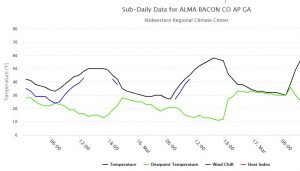I am working on a talk that I will be giving at the UGA Extension Winter School on Wednesday about freeze protection for fruit; my co-presenters are Drs. Erick Smith and Tim Coolong. In my part of the talk I describe the difference between advective and radiative freezes. Advective freezes occur when cold and (often) dry air blows into a region from somewhere else. Radiative freezes occur when clear, calm conditions allow heat to escape from the surface of the earth out to space, dropping the local temperature. In radiative freezes you frequently have a warmer layer of air above the surface called an inversion which can be tapped by fans to help prevent freezing temperatures near the ground. Unfortunately, this warm layer generally does not exist in cold advection, especially if the winds are strong, so fans and helicopters are not very effective in advective freezes.
Interestingly, both types of freezes occurred in the March 2017 freeze event. The graph below shows the temperature, dewpoint and wind chill at Alma’s airport in southeastern Georgia from March 15 to 17, 2017 (from the Midwestern Climate Center’s cli-MATE website). The first night, March 15-16, was an advective freeze, with temperature and dewpoint both dropping through the night. One of my meteorologist friends later traced the air from that night all the way back across the North Pole to Siberia. No wonder it was so cold and dry! The blue wind chill line below the temperature curve shows that winds were pretty gusty that night as the cold air poured in. The next night (March 16-17) there was little wind and the temperature dropped down quickly after sunset and approached the dewpoint temperature and leveled off later that night, which is pretty typical for radiative freeze events.
For some stations, the temperature was lower on the second night than the first. The big difference is the humidity as shown by the lower dewpoint temperatures on the first night. That low humidity as well as the higher winds made it tough to do freeze protection by irrigation for the March frost. I’m looking forward to hearing more about it from Erick and Tim on Wednesday.
